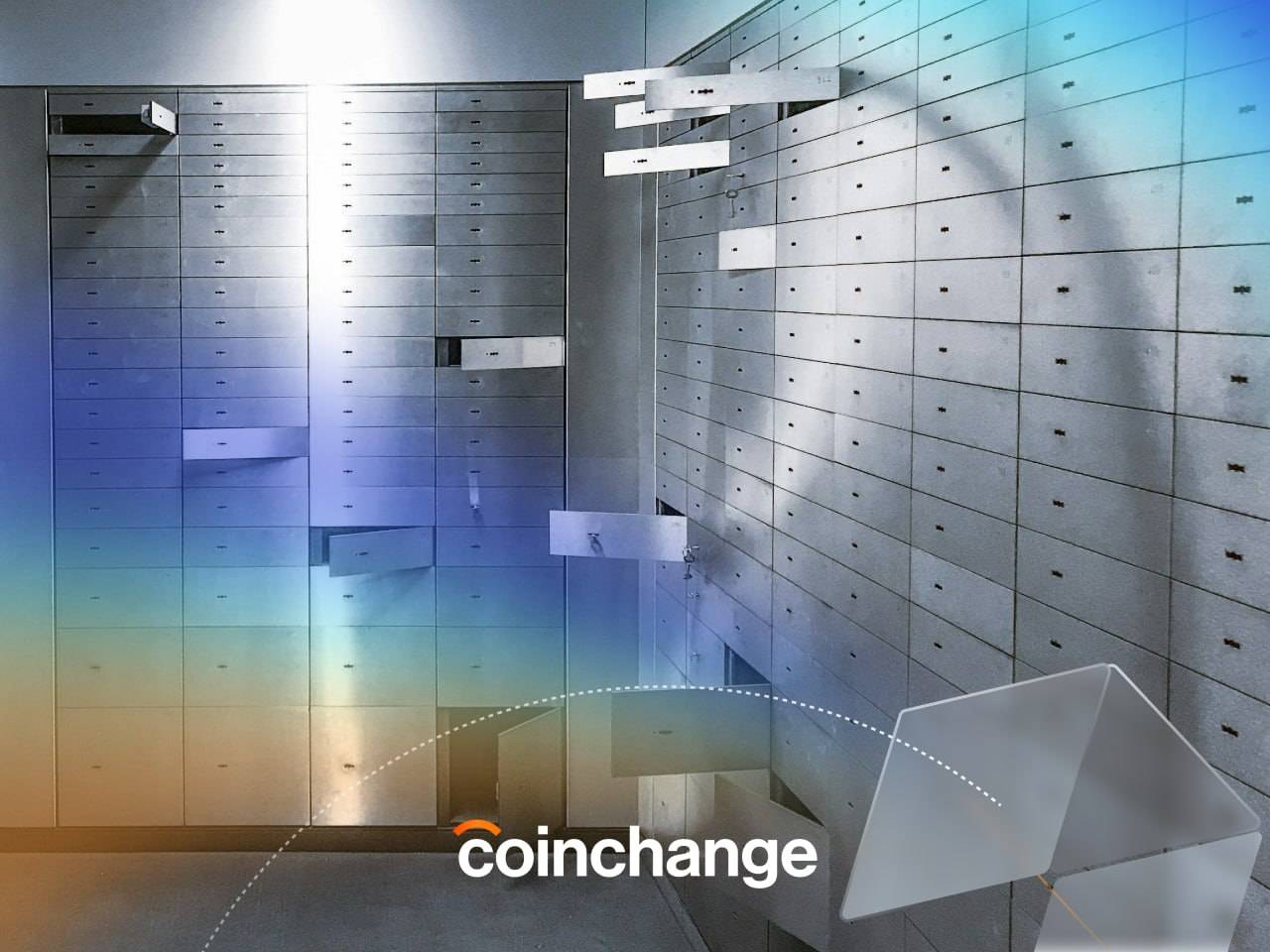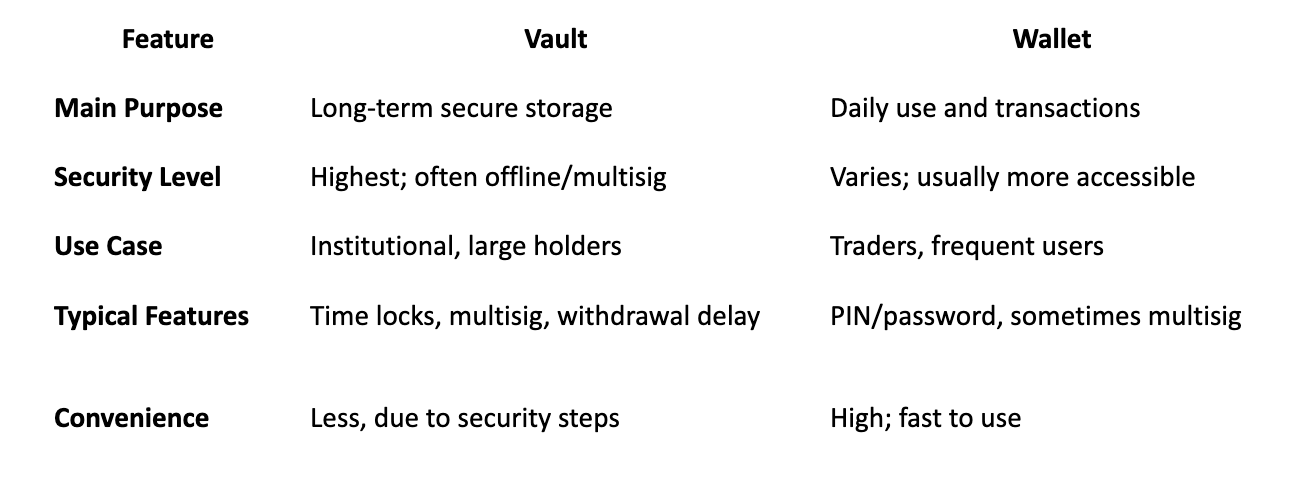VAULTs – What They Are, How They Work

Vaults are essential for the safety of your cryptocurrency assets.
As the demand for storing your investments/assets grows more and more, the solutions come along as well. In this case, one of the most important innovations in this area are crypto “vaults” - which are designed not just for safekeeping but also for programmable, secure, and often yield-generating interactions with crypto assets. Vaults are evolving from cold storage concepts into composable smart contract infrastructures that can do more than just hold assets - they can deploy, earn, restrict, and distribute them.
What is a Crypto Vault?
A crypto vault is a safe storing solution for cryptocurrencies.
It is like a secure digital safe (therefore it is called a “vault”) made to store and manage cryptocurrencies for the long term, with built-in rules that control who can access it and how it works to keep the assets safe. Unlike standard wallets, which are for the ease of use and frequent transactions, vaults focus on security, governance, and smart contract programmability. These systems are particularly useful for managing risk, enforcing access rules, and optimizing asset utility - especially when it comes to interacting with DeFi protocols.
Use Cases
Vaults are primarily used by institutionals to protect their assets, with the following being some common use cases:
- Cold storage of large institutional holdings
- DAO-controlled treasuries
- Protocol-level reserves and on-chain governance
- Treasury management for fintech apps
- Automated, rule-bound DeFi yield deployment
- Token streaming or vesting contracts
Used By
This is who typically uses digital asset vaults:
- Institutional asset managers (e.g., family offices, hedge funds)
- Protocol treasuries (e.g., DAOs, Layer-1 teams)
- Crypto custodians and prime brokers
- Fintech platforms offering white-labeled investment products
- Individual HNW investors using self-custody setups
The Benefits of Vaults
Vaults offer more than simple storage - they deliver policy-based automation, access control, and flexible yield strategies.
Key benefits include:
- Multi-layered security (e.g., multisig, time locks)
- On-chain programmability
- Integration with DeFi protocols
- Role-based permissions and access rights
- Transparent reporting and risk analytics
- Offline and non-custodial options
Different Types of Crypto Vaults
Vaults come in different forms depending on their function and the required balance between security, programmability, and flexibility. Below are the main types commonly used across the crypto ecosystem.
Smart Contract Vaults
Smart contract vaults are programmable asset containers deployed on-chain that enforce rules over how, when, and by whom assets can be moved. They serve both operational and investment purposes.
Common Features:
- On-chain logic execution.
- Support for tokenized portfolios.
Permissioned access controls. - Automated yield farming or staking.
- Composability with other DeFi contracts.
These vaults are ideal for fintech platforms, DAOs, or protocols needing automated and auditable yield and treasury operations.
Time-locked Vaults
Time-locked vaults enforce a delay on withdrawals or transfers, offering security through enforced illiquidity.
Common Features:
- Fixed unlock date or block height.
- Gradual vesting schedules.
- Withdrawal cooldowns.
- Emergency delay features.
This structure is common in token vesting contracts or delayed withdrawals in protocol treasuries, preventing sudden, unauthorized exits.
Multi-Signature Vaults
These require multiple parties to approve transactions before funds can be moved. This adds a layer of human governance.
Common Features:
- M-of-N signature approvals.
- Threshold cryptography.
- Wallet segmentation by role.
- Audit logs for all actions.
They’re widely used by DAOs, companies, or teams where no single person should control treasury operations.
Hybrid Vaults
Hybrid vaults combine features from time-locks, multisig, and smart contracts to create layered, programmable control.
Common Features:
- Time-delayed multisig with fallback logic.
- Vault logic integrated with off-chain reporting.
- Access roles based on time and identity.
- Policy-based automation and overrides.
These are popular with advanced fintechs and institutional-grade platforms managing both user-facing and backend treasury logic.
Comparison: Vaults vs Wallets
While both store assets, vaults are designed for security and programmable management, whereas wallets are made for convenience and frequent use.

Who Uses Vaults?
Vaults are used by a growing segment of the crypto economy that prioritizes security, control, and auditability.
Common Users:
- Institutional investors and funds.
- Fintechs embedding DeFi services.
- Protocols managing treasuries.
- Crypto-native neobanks.
- Compliance-focused DeFi builders.
Their adoption is accelerating as regulatory frameworks demand greater visibility and control over how assets are stored and moved.
Tokenized Vaults
Tokenized vaults are smart contracts that represent pooled or managed assets via ERC-4626 or similar standards. When users put money into the vault, they get a token, such as a "vault share." The value of the token goes up as the underlying strategies operate. In DeFi, you can move these tokens, keep track of them, and even use them as collateral.
This structure enables transparent, permissionless access to complex investment strategies without requiring custody transfers or centralized control.
Example of Smart Contract Vault Integration – Coinchange
Coinchange integrates smart contract vaults as tokenized investment vehicles. These are accessible to self-custody users, DAOs, and protocols who want exposure to Coinchange-managed portfolios without relinquishing control of their assets.
What the integration provides:
- ERC-4626 compliant tokenized vaults.
- No custodial control over user funds.
- Daily NAV calculation and smart contract reporting.
- Access to engineered multi-strategy portfolios.
- Permissionless subscription and redemption.
These vaults integrate seamlessly with Coinchange’s infrastructure, delivering compliance-ready performance and automated reporting via WebSocket/API or dashboards.
Coinchange: Using Vaults for Yield Generation
Coinchange uses its vaults as part of a broader yield infrastructure. Vaults deploy assets into diversified, risk-scored portfolios built from a curated universe of CeFi and DeFi strategies. The FARM™ engine evaluates every strategy for risk-adjusted return before capital is allocated.
Assets in vaults are deployed dynamically:
- To delta-neutral funding and basis strategies.
- To DeFi protocols with real-time monitoring.
- To manage directional sleeves based on risk limits.
- Rebalanced monthly or based on signal overrides.
Vault users earn yield transparently, with live P&L, NAV reporting, and automated fee structures. Coinchange earns performance fees while offering API partners rev-share on platform earnings.
Conclusion
Crypto vaults are no longer just digital safes - they're programmable infrastructure for secure, efficient, and transparent digital-asset management. Whether used for compliance-heavy institutions, DAO treasuries, or DeFi-integrated fintechs, vaults enable a new paradigm of on-chain capital control. Platforms like Coinchange are pushing this frontier forward by combining engineered portfolios, risk analytics, and tokenized vault access.
FAQ
Are Vaults secure?
Yes. Vaults use time locks, multi-signatures, and smart contract constraints to maximize asset security.
What is the difference between a VAULT and a cold wallet?
A cold wallet is offline storage; a vault can be online, programmable, and supports automated logic or rules.
Are Vaults always time-locked?
No. Some vaults use time locks, others use multisig or smart contract logic depending on the use case.
Does Coinchange use Vaults?
Yes. Coinchange uses smart contract vaults for tokenized portfolios, allowing self-custody interaction.
How do Coinchange smart Vaults help with yield generation?
They enable programmable access to engineered, multi-strategy portfolios that deploy assets for yield across CeFi and DeFi venues.
Can Vaults be tokenized?
Yes. Platforms use ERC-4626 to wrap vaults into transferable, composable tokens.
Can individual investors use Vaults?
Yes. Via Web dashboards or partner apps, retail investors can access tokenized vaults with preset strategies.
Read more:
Bitcoin in Your 401(k)? Deep Dive into the Trump Executive Order and Its Consequences
Pro-Crypto SEC Reform and Future Plans: A Deep Dive into the White House Crypto Report
CEXs Introducing Wealth Management Features & Why Coinchange Is Especially Important Now




